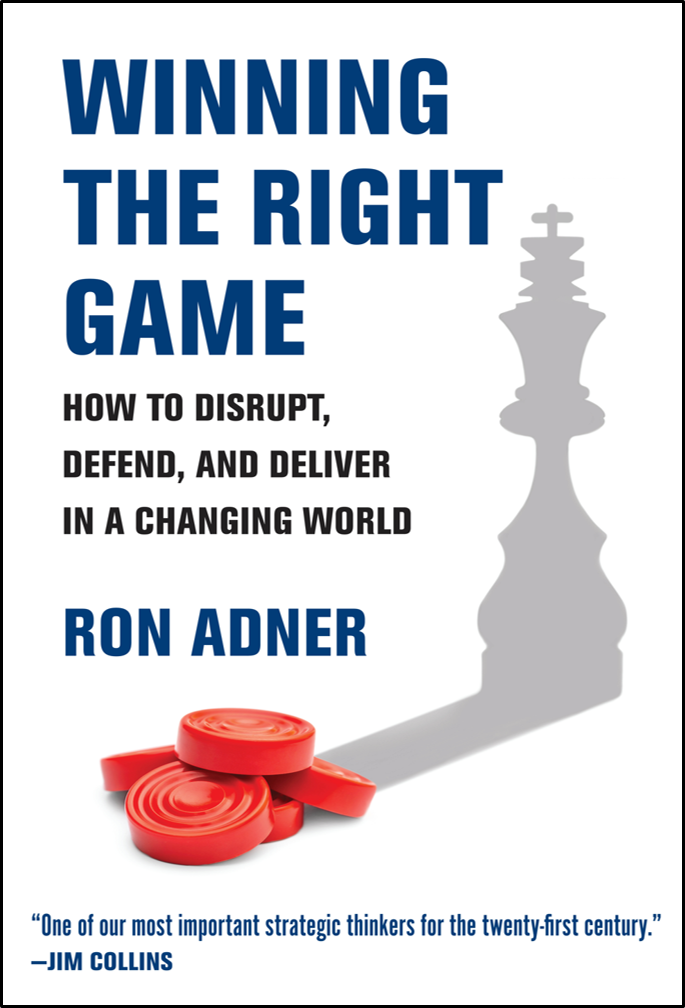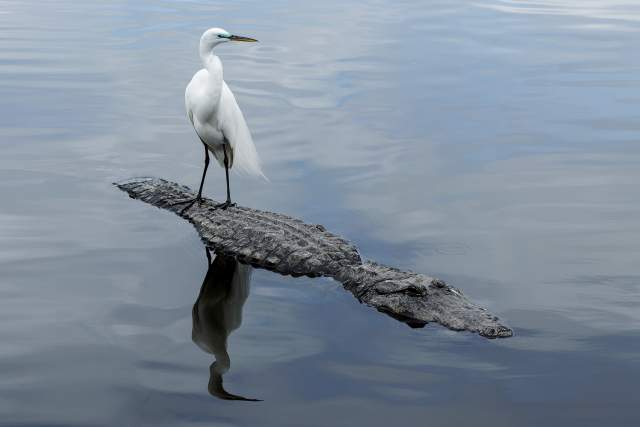Ron Adner likes to think big. In his first book, The Wide Lens: What Successful Innovators See that Others Miss (Portfolio, 2012), he gave the business world a new language and logic for the perennial problem of innovation. The blind spot of innovation was partnerships: who are the co-innovators and adoption-chain partners that you need to make your new product or service a lasting success? The book widened the focus from creativity and internal execution to an appreciation of the importance of the entire ecosystem surrounding an innovation, from tires to telcos, from pharmaceuticals to payment systems. The book was a critical success and changed the way academics and practitioners conceptualize and execute innovation.
Now, Adner is thinking even bigger. In his new book, Winning the Right Game: How to Disrupt, Defend and Deliver in a Changing World (The MIT Press, Oct 2021), Adner asserts the digital age has so altered business activities that our traditional approach to industries, strategy, and competition has become fundamentally inadequate. Disruption used to take place within industries—discount airlines, online brokerage, battery storage. But modern disruption breaks industry boundaries and redefines entire ecosystems.

The basis of competition is changing. Are you prepared? Winning the Right Game: How to Disrupt, Defend and Deliver in a Changing World is now available for order.
“Today there are multiple games being played simultaneously, so your new risk is that you could be trying to win the wrong one,” says Adner, the Nathaniel D’1906 and Martha E. Leverone Memorial Professor of Business Administration and Professor of Strategy and Entrepreneurship at Tuck. “The book is about how you rethink strategy and competition in a world where industry boundaries are no longer productive guides to defining who your rivals are.”
Modern disruption is ecosystem disruption. So, for example, while competition in the automotive industry has always been intense, it was centered on the same set of well-understood goals for a century. Car makers today, however, are scrambling to create strategies that make sense in the redefined “mobility ecosystem” that is being reshaped by Tesla, Uber, electrical charging, promises of autonomy—a diversity of business models and partnerships that present a fundamentally different set of tradeoffs.
The first chapter of the book re-examines the story of Kodak. Why did you choose one of the most well-known cases to retell?
Kodak’s famous bankruptcy is always presented as a failure rooted in organizational inertia in the face of the digital revolution. But this is 100-percent wrong. And the error demonstrates the need for a different set of strategy tools when competition breaks traditional industry boundaries.
Kodak bet big, made the hard transition from chemical to digital printing, and became a top printer maker. But even as it managed the disruption in printing technology, it was blind-sided as printing itself became irrelevant in a world of ubiquitous screens. Kodak was trying to beat HP and Lexmark in digital printing, but the real danger came from the iPhone, Facebook, and Instagram as they redefined digital viewing. This is a different kind of disruption, rooted in what I call ‘Value Inversion,’ and it requires a new set of tools to see coming. Kodak offers a stark demonstration that winning the wrong game is the same as losing. So the point of revising the story is to show that if you don’t have the tools to see and understand the larger game board, you are risking winning the wrong game as well.
Why is this shift from industry competition to ecosystem competition happening now?
Ecosystem disruption is not new, but the frequency with which firms are trying to create new ecosystems, and the number of ecosystems they are forced to participate in simultaneously, has picked up considerably. This is the next step in the digital revolution, and it’s not going away anytime soon.
You discuss the idea of ecosystem defense, through three David-versus-Goliath stories. Wayfair beat Amazon at online furniture, TomTom is a billion-dollar GPS company even though Google gives away free GPS data, and Spotify exists alongside Apple Music. Why is defense important in ecosystem competition?
Ecosystem defense is critical because ecosystem offense is all around. Kodak was driven to bankruptcy as unintended, collateral damage from a broader trend. Many firms, however, find themselves squarely in the sights of ecosystem disruptors who are very intentional about eating their lunch. The notion of needing to confront an Apple, Google, or Amazon in your home market is the new competitive nightmare. But there is a systematic way to respond to such attacks if you know how. This is the focus of the second chapter of the book: ecosystem defense must be pursued in a coalition. If you’re facing this new type of competitor that is bringing its own ecosystem into the game, you can’t beat them head to head. You have to recruit and redeploy partners, identify defensible ground, and discipline your ambition to sustain your defensive coalition. Wayfair, TomTom, and Spotify each demonstrate a different principle of ecosystem defense, and collectively reveal the keys to success in a future of ecosystem-based competition.
How does leadership fit into this new ecosystem-based competition?
This is a critical question, and one that I ended up approaching at two different levels: the level of the company in chapter 5, and then the level of the individual leader in chapter 6. At the firm level, companies can fall into what I call the “Ego-system Trap.” They don’t recognize when their growth ambitions are taking them into a new ecosystem, versus expanding their position in their old ecosystem. We see this in the contrast between Apple’s success in expanding from smart phones to tablets to smart watches, and all the associated apps; and its stark failure to meaningfully impact health, education, payments, smart home, and a slew of other self-proclaimed transformational ambitions. The ego-system trap arises when firms define their ecosystems around themselves, rather than their value propositions. This blinds them to the need to re-strategize the alignment of partners when they cross into new domains, which in turn leads to a lot of hype without a lot of traction. For individuals leaders, overcoming the ego-system trap depends on developing an alignment mindset. This requires skills that are more about diplomacy than authority. Shifting from a company-first to a coalition-first mindset can be a real challenge for traditional leaders. But there is a clear pathway that can be taken, and it is essential for success in driving new ecosystems.
How does your book build on the current principles of strategy as they are taught in MBA programs?
The classic strategy frameworks that are taught in all top programs were built for a world that respected industry boundaries. While those logics remain critical, if these are all you know then you are operating with a major liability in the modern era. With Winning the Right Game¸ I am introducing a new language, and a new set of concepts and frameworks, for understanding the dimensions of competition that arise in a world of ecosystems. These let us ask new questions about the architecture of value, the sustainability of collaboration, the timing of disruption, and much more.
These issues are critical as we train future leaders to effect positive change in the world. Successful leaders have an intuition for how to approach these challenges. My hope for the book is that it does not just sharpen the reader’s intuition, but that it gives them the language through which they can clarify the logic behind that intuition. This ability to communicate is the key to working effectively with colleagues and partners in a way that lets them understand your strategy. Which itself is the key to scaling productive insight, which is the key to progress.

